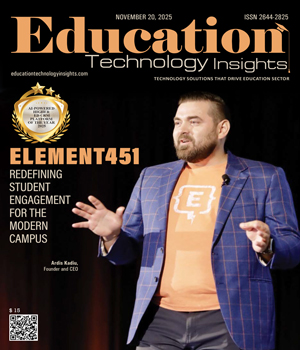THANK YOU FOR SUBSCRIBING
Be first to read the latest tech news, Industry Leader's Insights, and CIO interviews of medium and large enterprises exclusively from Education Technology Insights
Building Learning Experiences That Inspire Action and Reflection
Karl Kapp, Professor, Commonwealth University of Pennsylvania
 Karl Kapp, Professor, Commonwealth University of Pennsylvania
Karl Kapp, Professor, Commonwealth University of PennsylvaniaDr. Karl Kapp helps organizations and educators transform learning through technology, gamification and interactive design. He has authored ten books and shares insights that inspire meaningful engagement and practical application. A sought-after speaker and thought leader, Kapp guides learners and professionals to apply innovative strategies that make education more effective and action-oriented.
Teaching Learners to Think About Their Thinking
Over the years, learners have become more digitally savvy but also more distracted and reliant on technology without understanding how it works. With the rise of mobile devices, social media and now AI, many assume they “know technology.” Yet when asked to design an app, most don’t know where to begin.
Learners and even some EdTech leaders want immediacy, relevance and interactivity, but often lack clarity on how to achieve it in their studies or tools. They rarely approach learning from a metacognitive perspective. As educators, we must help learners think critically, reflect on their own thinking and recognize unseen influences on their learning.
This requires making learners active participants. Think practice, not just study. The future of higher education lies in creating labs where theories are applied, whether in science, accounting or history, within safe environments. Colleges and universities must become places where ideas are tested through action.
“Far too many EdTech tools rely on “gut feelings” and not sound theoretical underpinnings. A good instructional design for an EdTech project takes work, time and a bit of hands-on research which cannot and should not be ignored”
That belief inspired me to write Action-First Learning: Instructional Design Techniques to Engage and Inspire. At every level, educators should design instruction that starts with meaningful action, then encourages critical thinking and reflection. This sequence makes abstract concepts tangible and learning truly impactful.
Shifting the Focus from Tech to Learning
Too often the focus is on technology rather than learning. Instructional design methods and practices must drive outcomes, not flashy tools like VR or gamification. Purposeful interaction matters more than gimmicks and content should motivate learners with meaningful experiences. Designers also need a solid grasp of learning theories, such as cognitive load and self-determination, to apply frameworks effectively and create truly impactful learning. Far too many EdTech tools rely on “gut feelings” and not sound theoretical underpinnings. A good instructional design for an EdTech project takes work, time and a bit of hands-on research which cannot and should not be ignored.
Moving Beyond Passive Learning to Action-First Design
Three gaps stand out:
• Lack of Action. Many learning experiences still rely on passive content, slides, lectures, PDFs, which rarely work. Learners need to do, not just absorb. Instruction should include purposeful actions that keep learning active and engaging.
• Context. Instruction must be wrapped in stories, problems, simulations and real-world cases. Learners need the “why,” not just the “how.” Without relevance, engagement fades. For example, Algebra often frustrated me with problems like, “If a train leaves at 6:00 AM traveling 60 miles an hour…” I had never been on a train, so it lacked meaning. A better version would be, “You are 30 miles from soccer practice starting in 45 minutes. The coach will bench you if late. How fast must you drive to make it?” That context makes sense.
• Feedback. Learners need timely, focused feedback tailored to their actions. Yet many EdTech apps fall short, offering little beyond generic responses. Think of learning like a game: players receive constant feedback that guides improvement.
I believe these elements can be addressed by applying an Action-First Learning framework that starts with engaging task, embeds relevance, provides immediate feedback and encourages reflection.
As AI, AR, and other immersive tech become widely accessible, what opportunities, risks and mindsets do you think will determine the future of learning design?
Opportunities: There are a number of great opportunities that include truly personalized learning, scalable coaching, immersive practice, and adaptive simulations which all can be done with a combination of AI and AR and even VR. I look at the opportunity to create chatbots which are real-time interaction and see a great deal of learning opportunities. Tools like Open AI’s Study Mode and Google’s NotbookLM are two great examples of the world of opportunities.
Risks: However, there are also risks. I think the biggest risk is outsourcing creativity and pedagogy to the tech. AI can produce content, but it can’t replace human-centered, contextual design. AR can immerse, but without purpose it’s just a light show. We also risk creating an entire generation of learners who can’t think for themselves. We really need to emphasize critical thinking and forcing learners to think through solving of problems and not just solve problems.
Mindsets: We need to focus our EdTech application and our educational efforts on learner-centered, outcome-driven mindset. Ask, “What will the learner do differently?” Not just “What will they experience in our App?” Also, adopt a “design with, not for” approach. We need to co-create with learners. And this is now possible with quick development tools and AI that can do some of the back-end coding. Things are moving fast and we need to equip learners with the mind-set to keep up with the technological deluge.
What advice would you give young L&D professionals trying to design learning experiences that truly resonate with learners?
Start with what you want the learner to do, not what you want the learner to know. Do you want them to be active in civil discord? Do you want them to be a smart consumer of science? Do you want them to balance a budget? Do you want them to design instruction? Whatever you ultimately want the learner to be able to do is where you START the instruction. Begin with action first.
Read Also
Goldilocks Regulation
Beyond the Quiz: Redefining Competence in eLearning
Beyond Theory and Into Monday Morning: Enhancing Graduate Programs for Teachers
Safeguarding Students in the Age of Deepfakes: An Educational Imperative
Delivering Excellence in Education through Transformative School Leadership
Curriculum Innovation for Student Success and Institutional Growth

I agree We use cookies on this website to enhance your user experience. By clicking any link on this page you are giving your consent for us to set cookies. More info

However, if you would like to share the information in this article, you may use the link below:
www.educationtechnologyinsightseurope.com/cxoinsights/karl-kapp-nid-3406.html





















